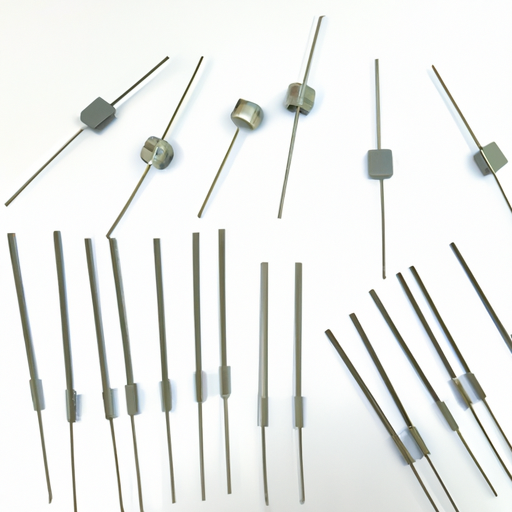Thermistors are temperature-sensitive resistors that are commonly used in electronic devices and systems to measure and control temperature. They are made of semiconductor materials that exhibit a large change in resistance with a small change in temperature. This makes them ideal for applications where precise temperature measurement and control are required.

1. Temperature range: Thermistors are available in a wide range of temperature ratings, from -50°C to 300°C or higher. It is important to select a thermistor with a temperature range that is suitable for the intended application.
2. Resistance value: Thermistors have a specific resistance value at a given temperature. The resistance value of a thermistor can vary depending on the material used and the temperature range. It is important to select a thermistor with the appropriate resistance value for the application.
3. Accuracy: The accuracy of a thermistor refers to how closely the measured temperature corresponds to the actual temperature. Thermistors with higher accuracy ratings are more suitable for applications where precise temperature control is required.
4. Response time: The response time of a thermistor refers to how quickly it can detect changes in temperature. Thermistors with faster response times are more suitable for applications where rapid temperature changes occur.
5. Stability: The stability of a thermistor refers to how well it maintains its resistance value over time. Thermistors with high stability ratings are more reliable and less likely to drift in resistance over time.
6. Size and package: Thermistors are available in a variety of sizes and packages, including surface mount and through-hole options. It is important to select a thermistor with the appropriate size and package for the intended application.
7. Environmental considerations: Some thermistors are designed to withstand harsh environmental conditions, such as high humidity or vibration. It is important to select a thermistor that is suitable for the environmental conditions in which it will be used.
In addition to these key specifications, there are also other factors to consider when selecting a thermistor, such as cost, availability, and compatibility with other components in the system. It is important to carefully evaluate all of these factors to ensure that the thermistor selected is the best fit for the application.
Thermistors are used in a wide range of applications, including temperature sensing and control in HVAC systems, automotive systems, medical devices, and consumer electronics. They are also used in industrial applications such as temperature monitoring in manufacturing processes and equipment.
In conclusion, thermistors are versatile and reliable temperature sensors that are widely used in a variety of applications. The latest thermistor specifications offer a range of options to suit different requirements, and careful consideration of these specifications is essential when selecting a thermistor for a specific application. By choosing the right thermistor for the job, you can ensure accurate temperature measurement and control in your electronic devices and systems.
Thermistors are temperature-sensitive resistors that are commonly used in electronic devices and systems to measure and control temperature. They are made of semiconductor materials that exhibit a large change in resistance with a small change in temperature. This makes them ideal for applications where precise temperature measurement and control are required.

1. Temperature range: Thermistors are available in a wide range of temperature ratings, from -50°C to 300°C or higher. It is important to select a thermistor with a temperature range that is suitable for the intended application.
2. Resistance value: Thermistors have a specific resistance value at a given temperature. The resistance value of a thermistor can vary depending on the material used and the temperature range. It is important to select a thermistor with the appropriate resistance value for the application.
3. Accuracy: The accuracy of a thermistor refers to how closely the measured temperature corresponds to the actual temperature. Thermistors with higher accuracy ratings are more suitable for applications where precise temperature control is required.
4. Response time: The response time of a thermistor refers to how quickly it can detect changes in temperature. Thermistors with faster response times are more suitable for applications where rapid temperature changes occur.
5. Stability: The stability of a thermistor refers to how well it maintains its resistance value over time. Thermistors with high stability ratings are more reliable and less likely to drift in resistance over time.
6. Size and package: Thermistors are available in a variety of sizes and packages, including surface mount and through-hole options. It is important to select a thermistor with the appropriate size and package for the intended application.
7. Environmental considerations: Some thermistors are designed to withstand harsh environmental conditions, such as high humidity or vibration. It is important to select a thermistor that is suitable for the environmental conditions in which it will be used.
In addition to these key specifications, there are also other factors to consider when selecting a thermistor, such as cost, availability, and compatibility with other components in the system. It is important to carefully evaluate all of these factors to ensure that the thermistor selected is the best fit for the application.
Thermistors are used in a wide range of applications, including temperature sensing and control in HVAC systems, automotive systems, medical devices, and consumer electronics. They are also used in industrial applications such as temperature monitoring in manufacturing processes and equipment.
In conclusion, thermistors are versatile and reliable temperature sensors that are widely used in a variety of applications. The latest thermistor specifications offer a range of options to suit different requirements, and careful consideration of these specifications is essential when selecting a thermistor for a specific application. By choosing the right thermistor for the job, you can ensure accurate temperature measurement and control in your electronic devices and systems.